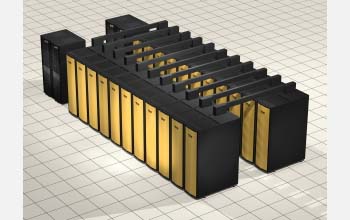News Release 04-133
National Science Foundation Awards $9.7 Million to Pittsburgh Supercomputing Center for Cray System
Red Storm to blow into Pittsburgh at the end of 2004

An artist's rendering of the new Red Storm system to be installed by Cray, Inc., at the Pittsbur ...
September 29, 2004
This material is available primarily for archival purposes. Telephone numbers or other contact information may be out of date; please see current contact information at media contacts.
ARLINGTON, Va.—The U.S. academic community will soon have access to a new supercomputer modeled on the highest-performance systems currently being built in the United States, through a $9.7 million award to the Pittsburgh Supercomputing Center (PSC) announced today by the National Science Foundation (NSF).
The one-year award will allow PSC to install a Red Storm system from Cray, Inc., capable of approximately 10 teraflops — 10 trillion calculations per second. The Pittsburgh system will be similar to the Red Storm systems currently being installed at the Department of Energy's Sandia and Oak Ridge national laboratories. The system to be installed at PSC at the end of 2004 potentially will provide the basis for greatly expanded capability in the future.
"The Red Storm system in Pittsburgh will enable researchers to explore the limits of high-performance computing and to demonstrate the potential of this architecture for a wide range of scientific applications," said Peter Freeman, head of NSF's Computer and Information Science and Engineering directorate. "The system will complement other systems already provided by NSF to the national community and will strengthen the growing high-end computing partnership between NSF and the Department of Energy."
Computational scientists have already lined up to use the Red Storm system at PSC for simulations of severe storms, blood flow and physiology, astrophysics, complex biological systems, turbulence and fluid dynamics, particle physics and earthquakes.
PSC's Red Storm system will be comprised of more than 2,000 AMD Opteron processors and will run a combination of the Linux operating system and a stripped-down Linux core derived from work on Sandia's ASCI-Red system for use on supercomputers with thousands of processors. Red Storm is distinguished by having an interprocessor bandwidth more than 10 times faster than that of any competing massively parallel system.
The PSC Red Storm is the final component of NSF's five-year Terascale Computing Systems initiative, which has provided for the acquisition of some of the most powerful computing systems available to the U.S. academic science and engineering community. When up and running, the new system will be integrated with NSF’s Extensible Terascale Facility (ETF) cyberinfrastructure project, as are PSC's existing LeMieux and Rachel supercomputers.
In a dramatic demonstration of advances in computing technologies, the new Red Storm system will occupy a mere 300 square feet of floor space, compared to the more than 4,000 square feet required to house LeMieux, installed in 2001 with a peak performance of 6 teraflops — at the time, the world’s most powerful supercomputing system for non-classified research.
-NSF-
Media Contacts
David Hart, NSF, (703) 292-7737, email: dhart@nsf.gov
Michael Schneider, PSC, (412) 268-4960, email: schneider@psc.edu
Program Contacts
Sangtae Kim, NSF, (703) 292-8970, email: skim@nsf.gov
Principal Investigators
Michael Levine, PSC, (412) 268-4960, email: levine@psc.edu
Ralph Roskies, PSC, (412) 268-4960, email: roskies@psc.edu
Related Websites
Pittsburgh Supercomputing Center: http://www.psc.edu/
The U.S. National Science Foundation propels the nation forward by advancing fundamental research in all fields of science and engineering. NSF supports research and people by providing facilities, instruments and funding to support their ingenuity and sustain the U.S. as a global leader in research and innovation. With a fiscal year 2023 budget of $9.5 billion, NSF funds reach all 50 states through grants to nearly 2,000 colleges, universities and institutions. Each year, NSF receives more than 40,000 competitive proposals and makes about 11,000 new awards. Those awards include support for cooperative research with industry, Arctic and Antarctic research and operations, and U.S. participation in international scientific efforts.
Connect with us online
NSF website: nsf.gov
NSF News: nsf.gov/news
For News Media: nsf.gov/news/newsroom
Statistics: nsf.gov/statistics/
Awards database: nsf.gov/awardsearch/
Follow us on social
Twitter: twitter.com/NSF
Facebook: facebook.com/US.NSF
Instagram: instagram.com/nsfgov


